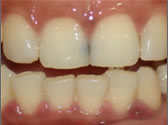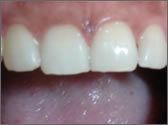

The term "dental bonding" can refer to a number of related dental techniques. In general, after a tooth's surface has been properly prepared, a white colored dental filling material is bonded onto the tooth. Dental bonding might be utilized as a way to improve the appearance of a cosmetic defect found on the surface of a tooth, to replace tooth structure that has chipped away or broken, or to repair damage caused by tooth decay. At an extreme, this technique can be used to resurface the entire front side of a tooth so to improve its cosmetic appearance.
As a benefit, when compared with the other cosmetic dentistry techniques reviewed on this page dental bonding can be relatively inexpensive and is usually a "completed in one visit" type dental procedure. As a disadvantage, dental bonding material has a tendency to stain as time passes and in general isn't as lasting or durable a treatment as other cosmetic dental procedures. However, and one more point in the plus column, if dental bonding does chip or break it can usually be easily patched or repaired.
Bonding: It is the use of a tooth colored restorative material that is applied on to the teeth. It can then be polished and shaped to look like the rest of the teeth.
 |
 |
Composite veneers cover the facial surface of teeth to change tooth color, position or shape. Addition of composite to tooth structure increases tooth size and therefore, there is often tooth reduction to make room for composite placement. Amount of reduction is determined by position of original tooth in relation to the desired position and color of tooth structure in relation to the thickness of composite materials required to block out color.
Diastema Closure.
A diastema is a space between front teeth. Diastemas are closed by orthodontics or restoration. A highly successful technique is addition of composite. A space which is too large and closed with composite results in teeth that are esthetically too wide and orthodontics is recommended. Space closure requires placement of composite two adjacent teeth. Placement of composite onto one tooth can be done it proper tooth dimensions allow it.
Peg Laterals
Peg laterals are small cone shaped teeth next to the maxillary central incisors. Teeth adjacent to peg laterals often shift into the space left by inadequate peg lateral dimension. Space analysis prior to restoration is critical for success. Shape of interproximal contours of adjacent teeth determines where contacts can be placed and what shape embrasures will form. Orthodontics, esthetic recontouring, or restoration of adjacent teeth might be required to achieve ideal esthetic results.
Composite restoration restores a peg lateral to normal shape, color and position.
Porcelain Veneers
A porcelain veneer is a thin shell of porcelain that is bonded onto the front surface of a tooth so to improve its cosmetic appearance.
A porcelain veneer can be an ideal way to make a cosmetic change for a tooth. Compared to dental bonding, porcelain veneers usually look more lifelike and they have the added benefit of resisting staining well. As a disadvantage, porcelain veneers are typically fairly expensive and if used in the wrong application can be prone to breaking. Unlike dental bonding, if a porcelain veneer has broken typically the whole veneer must be replaced. It usually cannot be patched or repaired.
If you've ever wondered why so many individuals have such perfect smiles, you might be surprised to find out how many of them have had cosmetic dental work done.
One way that we can make your smile more attractive is to place porcelain veneers or jacket crowns. Porcelain veneers are translucent, thin laminates made to improve the esthetics (shape, spacing, color) of natural teeth, to correct crowding, or to replace composite bonding.
If you already have crowns on your front teeth, replacement with all porcelain jacket crowns may give you a more natural, attractive appearance. Or think about cosmetic repositioning as an alternative to orthodontics with the placement of porcelain veneers.
Cosmetic Repositioning
Porcelain veneers and crowns are extremely lifelike and hold their brilliance, unlike bonding which often appears bulky or fake. Although porcelain is an extremely translucent material, it is also very strong. Porcelain veneers and crowns are permanent restorations, and they can be expected to last for many years. Also, there are no food restrictions - once they are cemented you can eat normally (apples, corn on the cob, etc.) - porcelain simply covers the imperfections in your own smile!
Porcelain jacket crowns and laminate veneers both require two office visits. At the first appointment we remove any old bonding and prepare the teeth. We also take impressions and choose the shade and shape of the porcelain. When you leave the office, temporary bonding is used to cover the prepared teeth. Approximately one week later, the porcelain veneers or crowns are permanently cemented at the second appointment.
They are often used to fix gaps between teeth, or cover stained or irregular teeth. This procedure is usually not reversible because a very thin surface of enamel is removed to give room for the shells.
All Porcelain Crowns
All Porcelain Crowns can provide the same sort of major cosmetic changes that porcelain veneers can make. However, unlike porcelain veneers that only cover over the front sides of teeth, All Porcelain Crowns cup over and encase the entire aspect of a tooth which lies above the gum line.
In comparison to porcelain veneers, All Porcelain Crowns are stronger and more durable but because making one involves trimming away a significant amount of tooth structure they usually aren't the best choice for making a cosmetic change for a tooth, unless the tooth also requires the non-cosmetic benefits the crown can provide. Like porcelain veneers, there is typically a fair amount of cost involved when All Porcelain Crowns are made.
Dental Jewellery
Teeth jewellery is a brilliant way to add sparkles to your smile and stand out of the crowd.
During a painless procedure, a dentist fixes a jewel on the tooth surface. The jewel does not damage tooth tissues and has no side effects except for the increased charm of your smile! Call it an oral fashion statement to stand out among ordinary mortals or simply an effort to blend in with the bold and the beautiful.
It puts an extra sparkle into more and more smiles. These Diamonds like jewels are applied to the labial surfaces of upper anterior teeth.
The trend is catching up with the youngsters at a rapid pace.
If somebody thinks he or she was better off without tooth jewellery, it can be easily removed without any side effects on the dental tooth structure as the procedure is non-invasive. What's more, tooth jewellery can be fixed again at a later stage.
 |
 |
SO WHAT ARE YOU WAITING FOR --- COME & HAVE THAT EXTRA SPARK*** IN YOUR SMILE
Comparing the longevity of Cosmetic Dental work
We would like to mention that some of the cosmetic changes you might choose to make with your teeth could have very long lasting consequences. Please realize that no dental work will last forever. This is especially true when cosmetics are a primary consideration
While a disadvantage of any teeth whitening process is that its effects will fade with time, a benefit of whitening in general is that as a process it makes no structural changes to a tooth. At some point in the future you can decide to or decide not to undergo the teeth whitening process again. Either choice is entirely optional or this leeway may make teeth whitening the best solution for your cosmetic needs.
To the contrary, having porcelain veneers or dental crowns placed means that there will always need to be a porcelain veneer or dental crown on the tooth. So, if a crown or veneer comes off, breaks, or just deteriorates from a standpoint of its appearance, another crown or veneer will need to be made. (You will have to ask your dentist for details regarding your specific situation but in general this applies to dental bonding as well.
Cosmetic Dentistry
We believe in giving a new perspective towards life to all those who lack self-confidence due to their marred smile. e.g.
Gingival Esthetic Surgeries :
Crown Lengthening
People having gummy smile with short crown are effectively treated by Gigivectomy which results into lengthening of crown, bringing beautiful smile.
De-pigmentation
Black pigmentation on gums can be removed surgically or with Laser, resulting in pink gingiva.